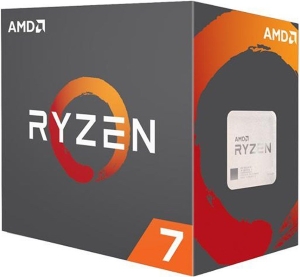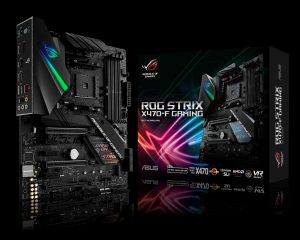Test – Asus ROG Strix X470-F Gaming et AMD Ryzen 5 2600X
| Specs | Price
Introduction
Hi all!
Rumors have been rife for some time on the upcoming release of AMD processors, the Ryzen 2xxx series, pre-orders were even officially opened a few days ago. In addition to the processors AMD gives us a new chipset, a high-end model for socket AM4, the X470! It is supposed to take over the “old” X370 and also natively support the new processors, something that could be a problem for old chipsets without BIOS updates as we have seen recently (here for example).
Today I will therefore offer you a double test, the new AMD Ryzen 5 2600X processor as well as a motherboard equipped with the latest X470 chipset, the Asus ROG Strix X470-F Gaming!
Characteristics
The Ryzen 2xxx range
| AMD Ryzen 5 2600 | AMD Ryzen 5 2600X | AMD Ryzen 7 2700 | AMD Ryzen 7 2700X | |
|---|---|---|---|---|
| Socket | AM4 | AM4 | AM4 | AM4 |
| Engraving fineness | 12 nm | 12 nm | 12 nm | 12 nm |
| Number of cores | 6 cores + 6 logic cores | 6 cores + 6 logic cores | 8 cores + 8 logic cores | 8 cores + 8 logic cores |
| Supported memory | DDR4 2933 MHz | DDR4 2933 MHz | DDR4 2933 MHz | DDR4 2933 MHz |
| Frequencies | Base: 3.4 Ghz Turbo: 3.9 GHz | Base: 3.6 Ghz Turbo: 4.2 GHz | Base: 3.2 Ghz Turbo: 4.1 GHz | Base: 3.7 Ghz Turbo: 4.3 GHz |
| Mémoicre cache L3 | 19 Mo | 19 Mo | 20 Mo | 20 Mo |
| TDP | 65W | 95W | 65W | 105W |
| Graphics part | Non | Non | Non | Non |
| Ventirad provided | Wraith Stealth | Wraith Spire | Wraith Spire (LED) | Wraith Prism (LED) |
| Price | 199$ | 229$ | 299$ | 329$ |
The new range of Ryzen should not normally lose the user a minimum informed of the previous models, indeed here we simply change the first number from 1 to 2 and it is settled! When we had the Ryzen 5 1600 its successor was the Ryzen 5 2600 and so on. There are 4 processors in the program, 2 of 6 cores and 2 of 8 cores, all with SMT therefore 12 or 16 threads in total.

On the 6-core side are the Ryzen 5 2600 and 2600X, with a base frequency of 3.4 and 3.6 GHz respectively for a Turbo of 3.9 GHz and 4.2 GHz. Compared to the old models we are facing an increase of 200 MHz base from 300 MHz in Turbo mode for the Ryzen 5 2600, the Ryzen 5 2600X meanwhile is at the same base frequency as its predecessor but benefits from 200 MHz more in Turbo mode, to see what it will give in the tests.
The TDP remains identical to the old models, with 65W for the Ryzen 5 1600 and 95 Watts for the Ryzen 5 1600X.

As for the 8 hearts, there are now 2 instead of the 3 we had on the old models. Indeed there is no replacement here for the Ryzen 7 1800X, but we should understand why by looking at the technical characteristics. AMD until then had limited its Ryzen processors to a TDP (and therefore maximum consumption) of 95 Watts, given that the architecture is (almost) identical and in order to offer a more efficient processor it was necessary to increase the frequency and AMD was therefore obliged to increase the TDP by 10 Watts at the same time to go to 105.
One can draw as a potential conclusion that AMD is getting the most out of its current architecture on these new processors, some will even assume that the overclocking margin should be limited (not to mention extreme overclocking). If a Ryzen 7 2800X would have been brought out the TDP would certainly have been even higher, but we never know the manufacturer could pull us one from behind the bundles one day.
The operating frequencies are increased compared to the old models, 3.2 GHz base (+200 MHz compared to the Ryzen 7 1700) against 4.1 GHz (+ 400 MHz!) For the Ryzen 7 2700 and 3.7 GHz (+300 MHz) base against 4.3 GHz (+500 MHz!) for the Ryzen 7 2700X. Here clearly the gain is nicer than what we see on the 6-core versions, especially on the turbo mode which gains between 400 and 500 MHz depending on the version.
The turbo frequency is however more important here than what was found on the old Ryzen 1xxx processors. Indeed and without going into too much detail AMD increases the frequency automatically and on the fly of the frequency according to the number of cores used. For example, if only one core is on load, it will have a higher frequency than if the load was on 4 cores, in order to provide the application with maximum performance.
For non “X” processors, the frequency drops sharply depending on the load, for the Ryzen 7 1700 at 3.7 GHz we can be on an application that requires 1 core and drop directly to 3.2 GHz (or less) for another application that asks for 3 hearts. On the new “X” processors, so the Ryzen 5 2600X and Ryzen 7 2700X AMD has added several “technologies” (XFR 2 Enhanced, Precision Boost Overdrive) to really adapt the frequency to the load in a more linear way.
Concretely instead of having frequencies that drop in steps of 100 MHz, this will be much more subtle and all this will be managed according to the consumption of the processor (while remaining within the limits of the TDP), its temperature and the limits of the motherboard (although I have doubts on this last point). To take advantage of these latest technologies, you must have a processor equipped with them (Ryzen 5 2600X and Ryzen 7 2700X for the moment) as well as a motherboard equipped with the X470 chipset. Indeed even if it has been said that the new AM4 processors will be compatible with all the old chipsets (A320, B350 and X370) some features will not be available, the XFR2 Enhanced and Precision Boost Overdrive included, to see in practice the difference that it could do.
The motherboard: Asus ROG Strix X470-F Gaming

| Asus ROG Strix X470-F Gaming | |
|---|---|
| Format | ATX (30.4 cm x 24.4 cm) |
| Socket | AMD AM4 |
| CPU | AMD AM4 Socket processor for AMD Ryzen ™ 1st and 2nd gen / 7th gen A-series / Athlon ™ |
| Chipset | AMD X470 |
| Memory | 4 x DDR4 up to 3466 Mhz “Dual Channel” Support XMP Maximum the 64 Go |
| Slots d’extensions | 3 x PCIe 3.0 16X (cabled in 16x / 8x) 1 x PCIe 2.0 16X (wired in 4x) 3 x PCIe 3.0 1X |
| Multi-GPU | AMD CrossFire 3-Way NVIDIA SLI 2-Way |
| Audio Chipset | SupremeFX S1220A (Realtek® ALC S1220A) |
| Wired Network | 1 x contrôleur Intel® I211-AT Gigabit LAN |
| Wireless network | Non |
| Number of connectors for fans / pumps | 7 x 4-pin PWM |
| Storage | AMD X470: 6 x Sata 6 Gb/s (Support des RAID 0, 1, 10) |
| USB | Rear panel: 2 x USB 3.1 Gen 2 Type-A 5 x USB 3.1 Gen 1 Type-A 1 x USB 3.1 Gen 1 Type-C Internal: |
| Video outputs | 1 x DisplayPort 1 x HDMI |
| Price | ~ 220€ |
The Asus ROG Strix X470-F Gaming is of course a motherboard equipped with the latest X470 chipset from AMD, in the standard ATX format of 30.4 x 24.4 cm, a model that will therefore fit perfectly into all ATX boxes on the market. Who says latest chipset also compatibility with the very latest 2nd generation AMD Ryzen processors, but also all previous models, that goes without saying!
The card is compatible with DDR4 of course, with frequencies that can go up to 3466 MHz in overclocking, which will be more than enough for all users. We know the concerns that there have been with Ryzen processors and the rather difficult increase in frequency in the past, so if the kits manage to operate at 3466 MHz then it will already be not bad.
There are 3 PCIe 16x ports, including 2 x PCIe 3.0 (16x / 8x cables) and 1 x Pcie 2.0 (4x cable). Up to 3 AMD Crossfire graphics cards or 2 NVIDIA SLI cards can be installed on these ports, if you feel like doing a multi-gpu configuration (with all the inconveniences that go with it!). In addition to that 3 Pcie 3.0 1x ports are there for any peripherals (sound card, WiFi card etc.).
The number of connectors for storage devices is fairly standard. Indeed we are entitled to 6 x Sata 6G / s all configurable also in RAID 0/1/10 as well as 2 x M.2 PCie 4x or Sata 6 Gb / s. So there shouldn’t be a problem if you have a “normal” configuration. Note, however, that if a device is connected to the PCIe x1_1 port, the M.2_2 port can only work in sata mode and not PCIe, you never know if this happens to you!
The network is entrusted to a Gigabit Intel I211-AT chip, an excellent model which should not pose the slightest problem, a good thing compared to a “simple” Realtek even if in practice well advised will be the one who will find the difference. The audio part is marketingly called “SupremeFX S1220A” to give a high-end impression, it remains a Realtek ALC S1220A chip on which we put a metal frame and high-end capacitors, everything will do the job perfectly well and should take care of our little ears.
Asus has sounded the port of USB 3.0 ports by offering only 3.1 (Gen 1 and 2) on the back, for a total of 8 in Type-A and 1 in Type-C. Of course internally we find the eternal USB 2.0 connectors, as well as 2 x USB 3.1.
Offered at a price of around € 220, the Asus ROG Strix x470-F Gaming offers everything a classic configuration needs, with a good sound part, a good network controller, SLI management and so on, we expected no less at this price though!














